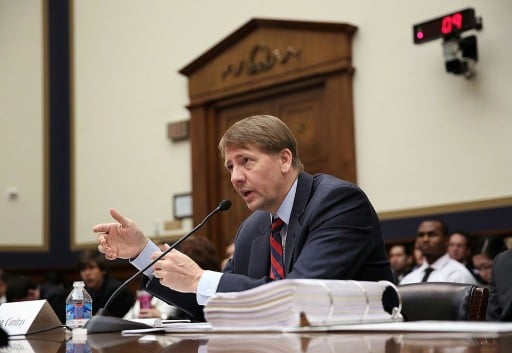
Alex Wong / Getty Images
The Consumer Financial Protection Bureau (CFPB) is a federal agency that aims to aid U.S. consumers by enforcing consumer-market financial rules. The CFPB’s mission is to protect consumers from unfair, deceptive, or abusive practices and take action against companies that break the law. The CFPB, which was formed in 2010, is a consolidation of various consumer protection agencies and is vested with a high level of authority and independence.
Definition and Examples of the Consumer Financial Protection Bureau
The CFPB was formed in 2010 when Congress passed the Dodd-Frank Wall Street Reform and Consumer Protection Act in the aftermath of the financial crisis of 2008. President Obama consolidated various consumer financial protection authorities that were scattered across seven agencies into a single enforcement entity with heightened authority and independence. This was done in hopes of protecting consumers from the predatory behavior that contributed to the financial crisis.
Among other functions, the CFPB is responsible for ensuring compliance with the federal financial laws pertaining to banks, credit unions, credit cards, and home and college loans. Dood-Frank vested the CFPB with the power to regulate the activities of independent payday lenders, private mortgage lenders and servicers, debt collectors, credit reporting agencies, and private student loan companies—authority the federal government had never had before. The function of this authority is to police these entities for unfair, deceptive, and abusive practices harmful to consumers.
How the CFPB Works
The CFPB is divided into six divisions, which each carry out distinct functions:
- Consumer Engagement and Education: Educates consumers on finances with a special emphasis on underserved communities, older Americans, military families, and students
- Supervision, Fair Lending, and Enforcement: Ensures and enforces compliance with federal consumer financial laws
- Research, Markets, and Regulations: Researches consumer financial markets and consumer behavior, which then informs policies and programs
- The Office of General Counsel: Ensures the CFPB’s compliance with all applicable laws
- External Affairs: Maintains open lines of communication with external stakeholders, such as banks, government agencies, legislators, and the media
- Chief Operating Officer: Sustains the agency’s operational infrastructure
Note
The CFPB is not funded through appropriations like most federal agencies but instead through Federal Reserve earnings. These funds are allocated at the request of the CFPB.
CFPB Controversies
The CFPB has been the subject of its share of controversies. The bulk of the controversy stems from the bureau’s funding mechanism and its leadership.
How the CFPB Is Funded
The Federal Reserve transfers funds to the CFPB annually in the amount requested by the CFPB director, whereas most agencies are funded through Congressional appropriations. As such, the CFPB is not subject to the appropriations process nor the accompanying Congressional scrutiny. Some lawmakers have expressed concern over the fact that the bureau spends this money with no oversight from Congress, the president, or the Federal Reserve.
Further, the bureau is not subject to Office of Management and Budget (OMB) guidelines, rules, and regulations and does not need to comply with OMB Controller alerts. This fiscal structure is a source of consternation to many legislators.
Director of the CFPB
The CFPB is headed by a director who is appointed for a five-year term. The director is appointed by the president and is subject to Senate confirmation. Sitting presidents are limited in their ability to remove the CFPB director. Lawmakers have expressed concern over what they see as a design flaw: The bureau is controlled by a single individual who cannot be fired for poor performance and exercises sole control over the agency, its hiring, and its budget.
Note
In June 2020, the U.S. Supreme Court ruled that the director of the CFPB served at the president’s will. This ruling enabled President Biden to ask for the resignation of the serving director and appoint an interim director of his choice.
What Resources Does the CFPB Offer Consumers?
The CFPB provides a number of resources available to all Americans. These include online resources like links to free credit reports and sites such as FINRA Broker Check, which allows investors to investigate the status of a brokerage firm. The CFPB website also contains links to educational material and guides about everything from the basics of investing to personal finance courses for children.
Consumers can also submit a complaint directly on the CFPB website. The agency reviews all complaints to ascertain whether they warrant further action. The CFPB also publishes all complaint data while maintaining the anonymity of the complainer.
Alternatives to the Consumer Financial Protection Bureau
The CFPB is not the only entity that works to protect consumers. Other consumer finance focused federal agencies include the Federal Trade Commission (FTC). The FTC seeks to protect consumers by stopping unfair, anticompetitive, deceptive, or fraudulent practices in the marketplace through law enforcement, advocacy, and education.
Numerous state governments operate consumer protection agencies, some of which are modeled after the CFPB. The New Jersey Division of Consumer Affairs and the California Department of Consumer Affairs are two such organizations.
Consumers can also turn to nongovernmental consumer protection agencies. The most well known of these agencies is the Better Business Bureau, which publishes and investigates complaints against businesses and advocates on consumers’ behalf. Many nongovernmental agencies specialize in specific populations or industries, such as AARP, which looks out for older Americans, and the Center for Auto Safety (CAS), which is concerned with vehicular safety and standards.
Key Takeaways
- The CFPB is a federal organization enacted by the Dodd-Frank Act in the aftermath of the financial meltdown of 2008. The CFPB’s purpose is to protect consumers from predatory banking and lending practices.
- The CFPB enjoys a great degree of authority and independence. The bureau is funded by the Federal Reserve rather than through Congressional appropriations and is not subject to oversight by the Fed, Congress, or the president.
- Some legislators are irked by the CFPB’s level of authority and independence, raising concerns over the bureau’s susceptibility to corruption and abuse of power. In 2020, the Supreme Court ruled that the president has the authority to remove the director and appoint a replacement at will.
- The CFPB offers a variety of educational resources and tools. Consumers can also file a complaint for investigation.
- Alternatives to the CFPB include the FTC, state-level agencies, and nongovernmental entities.






